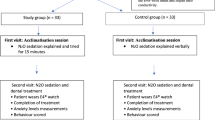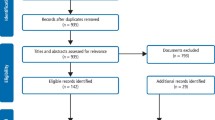Abstract
Data sources
Medline, PubMed, Embase, Cochrane Central Register of Controlled Trials, Dissertation Abstracts, SIGLE, the World Wide Web (Google) and the Community of Science Database were searched for relevant trials and references. Reference lists from relevant articles were scanned and the authors contacted to identify trials and obtain additional information. There were no language restrictions. Trials pre-1966 were not searched.
Study selection
Studies were selected if they met the following criteria: randomised controlled trials of conscious sedation comparing two or more drugs/techniques/placebo undertaken by the dentist or one of the dental team in anxious children up to 16 years of age.
Data extraction and synthesis
Information regarding methods, participants, interventions and outcome measures and results was independently extracted, in duplicate, by two authors. Specialist advice was sought to categorise interventions. Authors of trials were contacted for details of randomisation and withdrawals and a quality assessment was carried out not using any formal scoring system. The Cochrane Oral Health Group statistical guidelines were followed.
Results
Fifty-three studies were included with 2345 subjects in total. Overall quality of studies was found to be disappointing with poor reporting, often the main problem. Data reported could not easily be aggregated into groups to facilitate description of results. Meta-analysis of the available data was also not possible for the same reason. The variety of differing drug regimens compared made it difficult to isolate groups of studies that were sufficiently similar in design to allow sensible comparison. Where groups of studies could be isolated, the differing outcome measures used made their meta-analysis impossible.
Conclusions
Authors were not able to reach any definitive conclusion on which was the most effective drug or method of sedation used for anxious children. A list of proposed areas of study was described.
Similar content being viewed by others
Commentary
This Cochrane review aims to answer the question what is the safest and most effective way to provide conscious sedation for paediatric dental patients.
Despite the apparent simplicity of the question and the fact that 53 studies with a total of 2345 subjects were included in the review, the authors were unable to come to any definitive conclusions. Reviewing the literature in the area of sedation is a difficult exercise to undertake. The major selection problem is that the definition of sedation is not consistent across the world. In particular, much of the North American literature refers to ‘deep sedation’. This is a state of unconsciousness that is markedly different from the state of ‘conscious sedation’ as recognised in the UK.
The authors have attempted to restrict the analysis to those studies that were truly conscious sedation, but have been still unable to provide definitive recommendations. The studies have used differing outcome measures, and thus cannot be compared.
The outcome of this review is disappointing. There is a need to have an evidence-based approach to the management of anxious dental patients. The rush to institute appropriate conscious sedation techniques has been driven by the change in General Dental Council guidance from November 1998 and the publication of the report “A Conscious Decision” by the Department of Health,1 which stopped the provision of General Anaesthesia for Dentistry outwith the hospital setting. Unfortunately, the techniques that are often used now have evolved as one person's good idea, rather than a technique that has been robustly investigated. This has led to concerns as to the appropriateness of the management techniques that are currently being used.
The authors conclude their review by suggesting ways in which future trials should be conducted to improve their validity, allow comparison between studies and thus permit evidence-based practice to evolve.
There is an imperative for high quality evidence to be obtained; sadly, the new rules for ethical approval and drug trials are making such studies more difficult to initiate. Conscious sedation is by no means unique in dentistry in that there is little evidence-based practice. The sedation of paediatric patients is a politically sensitive issue at present. It is imperative that the dental profession learn from the mistakes that were made in the provision of general anaesthesia for dentistry, namely that contemporary standards must apply to the management of patients wherever their treatment is carried out.
The conclusion of this review should be that those who design sedation trials must look to provide a more consistent approach to allow better evidence to be produced in this important area of practice.
Practice point
-
Better designed trials that allow between studies comparisons are required to improve the evidence base in conscious sedation.
References
A Conscious Decision: Report of a Group chaired by the Chief Medical and Chief Dental Officer. London: Department of Health; 2000.
Author information
Authors and Affiliations
Additional information
Address for Correspondence; Emma Tavender, Review Group Co-ordinator, Cochrane Oral Health Group, University Dental Hospital of Manchester, Higher Cambridge Street, Manchester, M15 6FH. E-mail: emma.tavender@man.ac.uk
Matharu LM, Ashley PF. Sedation of anxious children undergoing dental treatment. The Cochrane Database of Systematic Reviews 2005, Issue 2. Art. No.: CD003877
Rights and permissions
About this article
Cite this article
Robb, N. Which is the most effective drug or method of sedation used for anxious children?. Evid Based Dent 6, 71 (2005). https://doi.org/10.1038/sj.ebd.6400344
Published:
Issue Date:
DOI: https://doi.org/10.1038/sj.ebd.6400344



